Kasiya is a small mineral moon located in the Caelus System whose surface was covered with a thin layer of ice over its reddish soil. Following the Elysian Incident, solar flares from the Caelus Star had an effect on the atmosphere of Kasiya which caused the development of several different biomes that had not existed prior to the event. With the natural effect that the Pomojima shard had on kyber crystal growth, Taldryan scientists utilized it in these newly formed biomes and found that it increased their development exponentially with sometimes dangerous temperature shifts in localized areas. Since then, the experiments were halted pending further investigation. Overall the moon continued to grow and develop into a more colonizable world even after that.
Description
The moon is rich in various minerals with a tundra crust covering much of the supercontinent's surface and large crevasses of dark blue, almost black-colored silicate breaking through the surface in several areas of the landmasses. These particular landmasses are dominated by large flats, jagged rock formations, broad mesas, narrow canyons, and sunken waterways, presenting the greatest threat due to the unknown effects that occurred after the solar flares, particularly in the abrupt growth and evolution of the wildlife and fauna.
The moon has a cold climate reminiscent of a permanent winter and an atmosphere breathable to oxygen-breathers, such as humans. The tundra surface is overgrown by dwarf shrubs, sedges, grasses, and mosses in the twin grassland regions and the Eastern and Western Frostlands. In some areas, the tundra surface was nearly destroyed by the sudden growth and development of the Biask Canyon and Great Kasiyan Desert, where nearly all of the moisture evaporated or disappeared. The moon’s low temperatures often leave the surface slippery and somewhat hard to travel. Kasiya is home to several settlements of differing sizes with the most prominent being the Taldryan capital and seat of power: Port Kasiya.
Geography
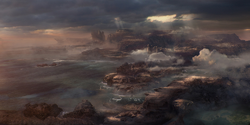 The coastline of the supercontinent
The coastline of the supercontinentWhile 78% of Kasiya is covered by ocean, the rest of its surface is covered by a single supercontinent made up of high, rocky coastlines, snow-capped mountain ranges, a desert, plains, and several other types of biomes that are continuing to evolve at an accelerated pace.
Climate
Kasiya has a cold climate with average temperatures ranging between slightly beneath 0°C and 10°C. In some areas such as the Great Kasiyan Desert, however, temperatures reach close to 30°C with virtually no moisture content.
History
Hidden underneath Kasiya's chill silicate crust are rich deposits of various more or less precious minerals and crystals that are mined from maze-like excavations. First designated as silicate mines, at some point, miners found various crystals, of which some were mistakingly taken for Kyber Crystals but further research revealed them to be mostly Ranite crystals. In fact, Force-sensitives from Taldryan have proven the existence of Kyber Crystals on Kasiya through their resonance in the Force but of about one million crystals on Kasiya, only a handful is attuned to the Force, making any large-scale mining operation too expensive for a viable profit.
However, some of the more sophisticated force-sensitive researchers of Taldryan believe that by placing the remains of the Orb of Pomojema in one of the crevasses with a considerable high concentration of Kyber Crystals could have a positive influence on the growth of crystals attuned to the Force on Kasiya.
Following the solar flares that altered the moon's atmosphere during the Elysian Incident, resulting in a shift of the moon's biomes, they tested this theory by utilizing pieces of the orb's remains around the surface of the moon to see what kind of effect it would have. In some areas, it had positive results such as the development of the Karufr Lowlands and the Amur/Marid Plains, and exceptional success in the development of the Shada Jungle.
In some places, however, the effects would prove catastrophic, the worst being when a large piece of the orb's remains was lost in the Phendrana Drifts when massive ice formations grew all over the area in a matter of weeks after its placement, resulting in the entrance cavern to the Crystal Valley being destroyed to prevent the growths from extending into the Amur Plains. Other areas affected were the Kasiyan Wilds, Jagd Wastes, and what has now been renamed the Forceless Forest where an ancient temple resided but now is cut off from civilization.
Kasiya World Map
See: [World Map]
Cities
Port Kasiya
See: Port Kasiya
Caleria
See: Caleria
Third City (TBA)
Jedi Temple (TBA)
Sith Temple (TBA)
Kasiya Regions
Central Kasiya
Arreat Mountains
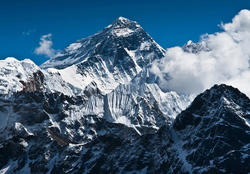 Mount Arreat, at the highest survivable location.
Mount Arreat, at the highest survivable location.The central mountain system stretches from the heart of Central Kasiya to Southern Kasiya, the Arreat Mountains contain some of the coldest locations on the moon due to their massive altitude. The peak of Mount Arreat itself extends into the final layer of the atmosphere. During the War of Port Kasiya, the Cloudhaven Defense Platform began an assault on Mount Arreat in an attempt to burrow to the core with its central cannon. This was averted by the combined efforts of Jorm Na'trej and Dasha Talus who together managed to both shut down the cannon and disable the platform before it could breach the outer mantle of the moon's core.
The platform collapsed into the hole it had created and sealed the magma chamber that had begun to develop. However, in recent months, it has been detected that magma has been able to escape through several ventilation shafts in the mountain and has begun to leak into the Shada Jungle in the east and Biask Canyon in the south.
Journeying into Cloudhaven however is still nigh impossible at the moment, due to the extreme heat and radiation levels that exist beyond its initial levels down into the crater.
Biask Canyon
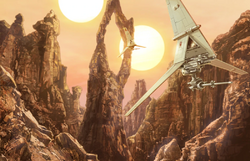 Aerial shot of the Biask Canyon range, Fein Flight in view.
Aerial shot of the Biask Canyon range, Fein Flight in view.Nestled in a valley between the Arreat Mountains and the Karufr Lowlands, Biask Canyon was one of the first major biomes to develop following significant tectonic activity after the solar flares struck the moon in 39 ABY. Still undetermined as to why, though the expectation is that the Cloudhaven platform has something to do with it, the entire canyon quickly shed any and all moisture from the air as well as the ground making it an extremely arid location. Due to that low moisture, extended exposure can result in significant dehydration through skin-based evaporation even with proper respiration, so only moderate excursions are approved at day while most missions or explorations are conducted at night when temperatures drop and some moisture enters the air from the Arreat Mountain range.
Numerous caverns and caves dot the canyon, and many lifeforms here have adapted to the environment presented requiring little or no water.
Karufr Lowlands
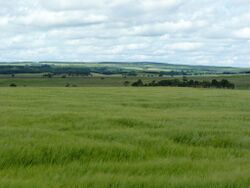 The Karufr Lowlands.
The Karufr Lowlands.The Karufr Lowlands is home to the Taldryan capital city of Port Kasiya located in the western section, as well as the moon's central grasslands. Containing peaceful wildlife and fauna, the lowlands are generally considered a safe area to be with minimal risk of incidents or threats to its inhabitants. At its lowest, this region sees temperatures around -14 to -15 degrees Celcius with the highs around 28 to 31 during the summer seasons, though the fauna reacts minimally due to being cold resistant and staying in bloom year round.
Small settlements and villages dot the region as well, for those who want to live calmer lives away from Port Kasiya or live in a quieter environment but still choose to work within the city's walls. Following the events of Great Jedi War XV, the crater that had been created by the impacting crystal meteor was restructured into a large lake fortress that would become the Taldryan Senate Complex.
Karufr Lowlands Locales
 Reddon Village
Reddon VillageReddon is a small village located on the north-eastern edge of the Karufr Lowlands, nestled at the foothills of the southern Arreat Mountains just opposite the Biask Canyon range. The position of the village within these foothills protects it from the harsh hot winds that flow from the canyons but also allow for easy expeditions into the canyons and easy observation should any local Tusken tribes try to make their way into the Lowlands.
The village, in addition to guarding the entrance of the Lowlands, specializes in raising Nerfs. It has a town hall, small medical facility, several farms, and homes for several hundred people. It has seen recent growth from individuals who have left Port Kasiya seeking a more simple life.
Karufr Highlands
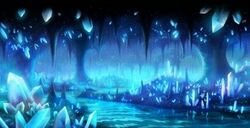 One of the kyber crystal caverns roughly 1 mile under the surface of the Highlands.
One of the kyber crystal caverns roughly 1 mile under the surface of the Highlands.The original area where the Orb of Pomojima was utilized, the Karufr Highlands has numerous chasms and cracks where kyber crystal production went into overdrive several miles underground. Tectonic activity however has halted much of the mining however, due to sightings of massive worms which are native to the Biask Canyon. It is thought that due to recent eruptions from Mount Arreat at the Arreat Crater causing lava to flow into the canyon, the worms are migrating south to avoid the dangerous lava streams.
New cave systems are constantly being found due to the worms tunneling underground, and as magma continues to spread the fear of it reaching these tunnels and flooding the mines has become of great concern to the clan and is something that needs to be addressed sooner than later.
Western Kasiya
Forceless Forest
 Picture of the Forceless Forest taken from the edge of the Jagd Wastes cavern access, 40 ABY
Picture of the Forceless Forest taken from the edge of the Jagd Wastes cavern access, 40 ABYOne of the last areas to be experimented on using a fragment of the Orb of Pomojima, the results turned out to be catastrophic. Shortly after its placement, contact was lost with the entire research team and Dark Jedi escort that had come with them. A search and rescue team had been dispatched but was unable to progress any further than the southern edge of the Kasiyan Wilds due to a sudden shift in toxicity in the environment of the Jagd Wilds, renamed the Jagd Wastes after this incident. Aerial incursions into the forceless forest have proven more successful, only in the regard that they make it into the forest...but are never seen or heard from again the moment they pass through the dense mists that envelop this lifeless area.
Despite all attempts even by the summit of the clan, everything within this region can no longer be felt in the force, and nothing from the ancient sith temple contained within as well. Due to the extreme danger and risk, this region was categorized as a quarantine zone with no approved entry without the express approval of the Taldryan Republic's Supreme Chancellor.
Jagd Wastes
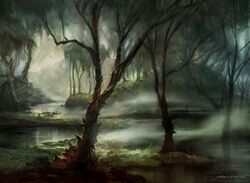 The toxic lands of the Jagd Wastes
The toxic lands of the Jagd WastesPreviously a swamp-based region, the Jagd Wilds as it was known then was home to numerous types of air-based wildlife and dozens of types of flora. After the failed orb experiment in the Forceless Forest, however, the swamp turned toxic and killed nearly all of the wildlife and flora. Those that did survive, however, were warped into forms unrecognizable from their previous states where the flora is just as deadly as the fauna. The swamp itself is also home to a toxic form of Rancor, which dominates as the apex predator here.
Some who have returned from this region had lost their minds, according to medical staff at Taldryan Tower, each having a small puncture wound on their neck and a strong desire to kill those around them. It is suspected that the plant life has a unique ability to corrupt a persons mind, though testing of this theory has not yet been done.
Kasiyan Wilds
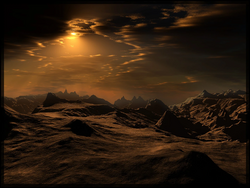 The Kasiyan Wilds.
The Kasiyan Wilds.Located directly to the west of the Kaurfr Lowlands and the western perimeter of Port Kasiya, the Kasiyan Wilds contains much of the more violent creatures due to the lesser extent of flora and game for them to eat, but also more of the lucrative rewards in the mines and chasms.
Similar to the Karufr Highlands in the coloring and type of tundra crust that covers this region, that is where the similarities end. After the change in climate following the solar flares, much of the distinct red-colored flora died off.
This change resulted in many areas becoming more barren, with dense mists at night. Much of the life here has adapted to this with increased hearing ability and more quiet movements to compensate for that.
On some recent excursions to this region, it has been thought that there could be some surviving nomadic groups of Twi'lek whom left Port Kasiya after the war. This is due to finding deserted encampments and single-file tracks through the tundra. So far all attempts to locate and contact them have ended in failure, with several deaths from unknown locations with ranged weaponry.
Western Red Hills
 The Western Red Hills
The Western Red HillsRaising above the Kasiyan Wilds along the shoreline, the Western Red Hills still hold their original namesake having been unaffected by the solar flares.
Large trees with red leaves dot the region, with numerous types of red-hued plants and grasses. Many of the smaller creatures that live here migrated from the Wilds, with the larger creatures having been unable to fit into the narrow crevices or climb the rocks enough to reach this zone.
With its location, several different auroras can be seen at night when the moon is positioned on the side of Perune's orbital zone, letting light reflect off both atmospheres.
Of all the regions of Kasiya, this is the second most calm and peaceful...despite the redness.
Northern Kasiya
Icelands
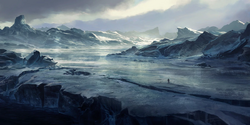 The southern edge of the Icelands, an expedition leader looking north.
The southern edge of the Icelands, an expedition leader looking north.Little is known about this region of Kasiya due to its unusually extreme cold temperatures and the inability of most engine-based systems to operate here without quickly freezing over. During the day, highs here only reach roughly -72 Celcius. At night, most gauging equipment fails before it can make an accurate reading. Support equipment suffers the same fate as well, giving most excursions very limited range into the Icelands at current without a guaranteed risk of death.
Alternative methods to enter this zone are required before anything further can be accomplished here.
Phendrana Drifts
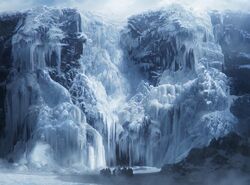 The sealed cavern entrance to the Phendrana Drifts from Amur Plains
The sealed cavern entrance to the Phendrana Drifts from Amur PlainsLocated in the northeast area of the Kasiyan continent, the Phendrana Drifts was once a simple valley of ice and snow with several temples contained within. Within several of these valleys were deep underground crevasses and large caverns that lead into several massive magma chambers where some kyber crystal production had begun to form.
After experiments with a fragment of the Orb of Pomojima, the ice formations quickly began to grow out of control at an accelerated pace even downing a Venator that was in orbit above the region offloading supplies and excavation personnel into the valley. With the ice growing out of control, the sole entryway into the Phendrana Drifts located at the mouth in a section called the Crystal Valley was sealed off to prevent it from escaping into the Amur Plains region of the moon.
Since this incident, little is known about the status of this region as no further attempts to enter have been made given the massive mist clouds which prohibit aerial travel due to a lack of visibility and room for maneuverability without hitting an ice pillar.
During the pirate assault on Chyron, one of the larger enemy capital ships that had attempted to escape made a last ditch-effort to evade Taldryan forces by flying into the canyons of Phendrana; but after disappearing from radar were not detected again. It was assumed the icy expansion within the valley claimed the ship.
Eastern Kasiya
Amur Plains
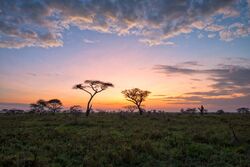 The beauty of the Amur Plains near the Shada Jungle.
The beauty of the Amur Plains near the Shada Jungle.Stretching the entire length of the western region from the Eastern Frostlands down to the Marid Plains on the coast, the Amur Plains is a sprawling region covered in a mixture of red and green grasses with small lakes and treelines dotted all over.
Much of the creature life here has adapted to this style of environment with increased running speed and agility, particularly a rare breed of Quenker which has reached speeds of up to 52 miles an hour when running. Many rich individuals from Port Kasiya come here to hunt, much to the protest and dismay of the Caleria citizens.
Eastern Red Hills
 The Eastern Red Hills
The Eastern Red Hills This area of the Red Hills is virtually indistinguishable from its counterpart, the Western Red Hills.
Great Kasiyan Desert
 The Great Kasiyan Desert.
The Great Kasiyan Desert.Found on the eastern edge of the Kasiyan continent, the Great Kasiyan Desert formed after the solar flares that struck the moon. The climate here took a massively sharp turn, with almost deadly temperatures and environment during the day reaching 62 Celcius and above, and at night as low as -52 Celcius. It also frequently has blinding sandstorms on a near daily occurance.
The primary issue with this is due to the severe lack of moisture, during the day the air is difficult to breathe, and without proper respiration can dry out a water-based oxygen-breathing lifeform's lungs in less than an hour. Similar protection is required at night to protect individuals from the extreme cold.
Various types of creatures live here, but primarily stay burrowed under the sand to protect themselves during the day like the massive sand worm and heat-resistant Womprats. Near its northern area lies a temple of unknown origin that had begun to be explored, but following the climate shift was quickly abandoned.
In terms of regions, next to the Forceless Forest, this region is easily the second deadliest purely because of the climate. Because of this, it is extremely recommended to travel in groups with large amounts of supplies and portable shelters to protect from the elements.
Marid Plains
 The Marid Plains outside of Caleria.
The Marid Plains outside of Caleria.Home of the resort city of Caleria, the Marid Plains are along the southern edge of the eastern region.
This region contains numerous farms and small towns, built to supplement and give additional supply for Caleria as well as themselves. It is covered with small hills, grass fields, and serves as a calm and quiet place to get away from things. In the western sections however, rumors of bandits have been surfacing whom have been attacking various settlements and outposts.
Shada Jungle
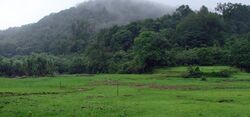 The outer perimeter of Shada Jungle from Amur Plains.
The outer perimeter of Shada Jungle from Amur Plains.Located along the edge of the Amur Plains and the Arreat Mountains, this dense jungle formed due to the massive cloud system that is held over it from the height of the mountains.
This has resulted in a substantial increase in rainfall, with creatures from the plains that did not adapt to greater speed having moved into. With the thick trees, speed is less of an advantage due to the risks of running into them. With this disadvantage, the creatures that live here excel at stealth and ambush. After the fall of Cloudhaven and the increase of magma flows in the north, however, some sections of the jungle have begun to burn with creatures fleeing south or out into the Amur Plains.
In the southern area, an ancient temple sits undisturbed and so far unfound the Taldryan Republic. Despite being seen from orbit as well as above the jungle, all attempts to approach it have failed and resulted in some "getting turned around and away from it without even realizing" as one explorer noted as if it were a labyrinth around its perimeter.
Plans are being made to attempt another excursion to the temple from multiple sides with aerial sensor tracking in an attempt to find a way to bypass this mysterious ward protecting it.
Southern Kasiya
Southern Ice Flats
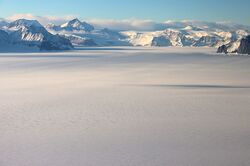 The Southern Ice Flats, looking back at the Highlands Wall.
The Southern Ice Flats, looking back at the Highlands Wall. Located at the southern edge of the Southern Kasiyan region, this area is one of the few unexplored areas of Kasiya. Not that its dangerous of course, but there has been little interest to come here given the various incidents occurring in the system as well as the other more intriguing things across the continent. What mysteries could this place actually hold within its lands?
Southern Red Hills
 The Southern Red Hills
The Southern Red Hills This area of the Red Hills is virtually indistinguishable from its counterpart, the Western Red Hills.
Similarly to the Southern Ice Flats, this area has seen little exploration.